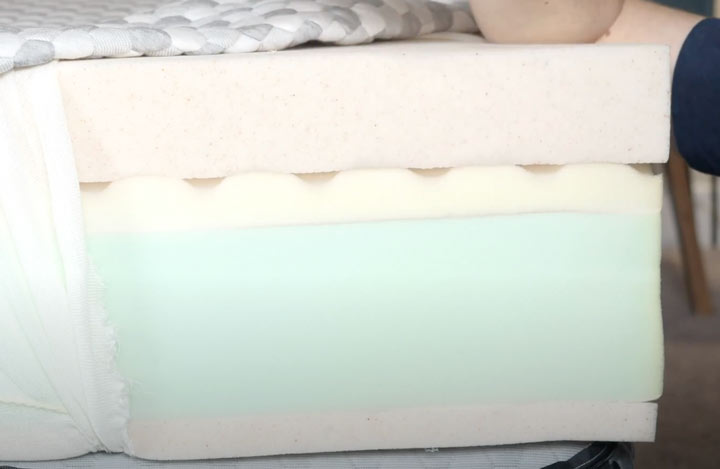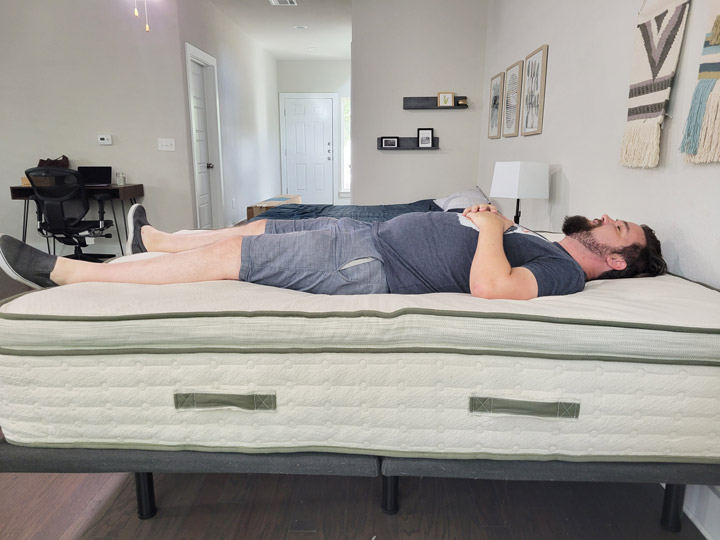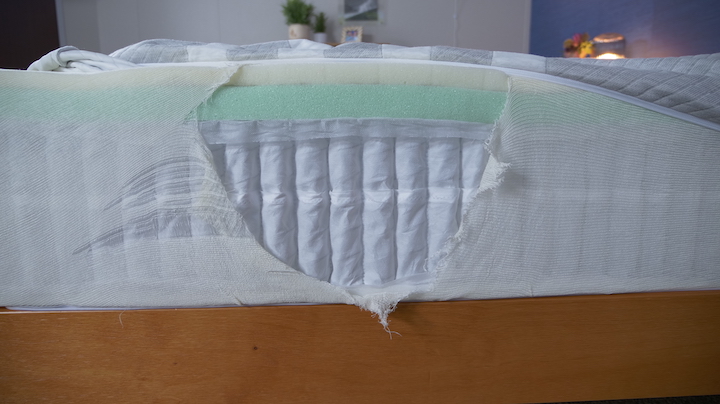If you’ve ever opened a brand-new mattress only to be hit with a strong, unpleasant odor, then you are familiar with mattress off-gassing. With such a strong, seemingly chemical-laden scent, it makes sense to wonder what exactly you’re breathing in and whether it’s safe.
Below, we detail the causes of off-gassing, which mattresses are best and worst in terms of off-gassing, and how we test off-gassing during our mattress assessments.
What Causes Off-Gassing?
Off-gassing occurs due to VOCs, or volatile organic compounds, that are a byproduct of the mattress manufacturing process. While off-gassing happens with many mattresses, it is most noticeable in bed-in-a-box mattresses that are packaged soon after manufacturing is complete.
Folding the mattress up and vacuum sealing it in plastic traps VOCs that would otherwise slowly dissipate over time. This is why you might get hit with a wall of chemical scent when you unpack your new mattress.
Is Off-Gassing Harmful?
Thankfully, short exposures to off-gassing appear to be relatively harmless for most people. While short-term exposure can be irritating, no studies currently link it to long-term health consequences, though research is ongoing.
That said, sensitive groups can experience some irritation from mattress off-gassing. The Environmental Protection Agency notes that VOCs can cause some short-term symptoms, including:
- Dizziness
- Nausea
- Headaches
- Allergic reactions
- Asthma
For most people, these symptoms will be short-lived and minor. However, sensitive groups may benefit from minimizing VOC exposure. Additionally, minimizing total off-gassing exposure for infants and children is a good idea, as their bodies are still developing and may be more sensitive to VOCs.
How We Test for Off-Gassing
We assess mattress off-gassing in two phases. First, we smell the mattress when it comes out of the packaging. Most memory foam mattresses have a strong chemical odor, and many organic mattresses smell earthy.
After we unbox the mattress, we place it on a bed frame and conduct all of our in-depth tests. Throughout, we keep monitoring its smell and whether it’s dissipating. We also come back to the mattress days later to see how it has expanded and off-gassed. Most of the time, we don’t smell anything when we return. But if the smell lingers, we make note of it in the published review.
We assign each bed an off-gassing score between 1 and 5. A perfect 5 means that the smell went away within 24 hours or less. A lower score means the smell lingered, sometimes beyond 2 or 3 days.
How Much Do Different Types of Mattresses Off-Gas?
How much your mattress off-gasses depends entirely on its materials. Understandably, heavily manufactured materials like polyurethane foam release more VOCs than natural and minimally processed ones.
Memory Foam

Memory foam mattresses contain a polyurethane base and various comfort materials that may include additional polyfoam or memory foam. These mattresses are the biggest culprit when it comes to off-gassing.
This doesn’t mean you need to avoid memory foam mattresses entirely—it just means you need to do your homework if you want to minimize off-gassing. Finding memory foam mattresses with certifications such as CertiPUR-US is an excellent way to avoid the more harmful VOCs.
Latex Hybrid

Another popular mattress material, latex, is great for sleepers looking for a supportive, responsive bed. Latex beds vary when it comes to off-gassing, depending on whether they contain natural or synthetic latex. Latex hybrids have more airflow than other latex beds due to layers of coils, which can help speed up the off-gassing process.
Natural latex mattresses should not have much off-gassing, as they do not go through the same manufacturing process as synthetic materials. If anything, all-natural latex beds have more of a “barnyard smell” when you first unbox them. On the other hand, synthetic latex beds have a similar off-gassing profile to memory foam beds.
Hybrid

Many people love hybrid beds for their support and comfort. Because hybrid beds consist of a coil base, there is much more airflow in this kind of mattress than all-foam foam beds. You will still encounter some off-gassing from the memory foam, but it should dissipate faster.
Innerspring
Innerspring mattresses are the lowest on the list of off-gassing offenders. Due to their open and airy construction, there is little to no off-gassing from innerspring beds. However, traditional innerspring beds—with coils and very little foam comfort layers up top—are often not the most comfortable or durable. Today’s mattress industry skews toward selling hybrids and foam models.
Certifications to Look For
If you want to minimize off-gassing, or at least ensure your bed isn’t releasing harmful chemicals into the air, check for mattress certifications. From verifying organic materials to testing for dangerous VOCs, trusted certifying agencies can help you know what you’re getting in your new bed.
Global Organic Textile Standard (GOTS)
The Global Organic Textile Standard, or GOTS, certifies organic textiles, including organic cotton mattress fabric. This agency holds manufacturers to rigorous standards in their materials and manufacturing processes. In addition to keeping companies honest regarding the mattress materials, GOTS assesses companies for fair trade and environmentally friendly practices.
Keep in mind that for non-latex mattresses, the GOTS certification only applies to the cotton portion of the mattress, so look for some of the other certifications listed below for the rest of the materials.
Global Organic Latex Standard (GOLS)
The same rigors of the GOTS certification apply to GOLS, the Global Organic Latex Standard. GOLS certifies natural, organic latex. Because this is the primary component of latex beds, buying a GOLS-certified mattress ensures its quality and safety. As with GOTS, GOLS also assesses companies for fair trade practices and environmental impact.
CertiPUR-US®
Since many bed-in-a-box mattresses contain memory foam, if you’re shopping online for your next bed, the CertiPUR-US® certification is something you should look out for. This certification applies to foam and ensures the materials used do not contain:
- Formaldehyde
- Ozone depleters
- Mercury, lead, and other heavy metals
- Phthalates regulated by the U.S. Consumer Product Safety Commission
It also certifies that the mattress releases low levels of VOCs and requires screening of all mattresses for fire retardants and other chemicals classified as mutagens, carcinogens, or reproductive toxins.
OEKO-TEX®
The OEKO-TEX® STANDARD 100 is similar to GOTS in that it certifies textiles. You will often see CertiPUR-US® and OEKO-TEX® listed together by companies, as the former applies to the foam that makes up the mattress, and the latter applies to the fabric casing.
This certification ensures that the mattress cover is free from chemicals that are harmful to human health. Although the OEKO-TEX® and GOTS certifications apply to similar aspects of mattresses, GOTS only certifies organic products. In addition, GOTS ensures standards at every step along the manufacturing pathway, while OEKO-TEX® only certifies the final product.
GREENGUARD GOLD
For a mattress to have a Greenguard Gold certification, it must pass rigorous testing for more than 360 VOCs. According to the company’s website, Greenguard Gold verifies that mattresses meet stringent health-based criteria and “requires lower total VOC emission levels to ensure that products are acceptable for use in environments such as schools and healthcare facilities.” This is a very high bar, and Greenguard Gold is an elite certification for mattresses.
How To Get Rid Of The New Mattress Smell
Even a super safe and certified mattress may still have an unpleasant odor for a few days after coming out of its box. Here are some tips to help you get rid of that “new mattress smell” as quickly as possible.
Unbox as soon as it arrives. If your new mattress arrives before your old one gets hauled away, you may be tempted to just leave it in the box and deal with it later. But the sooner you open the box and release it from its plastic wrapping, the sooner your mattress will finish off-gassing.
Place in a well-ventilated room. The VOCs that escape from your mattress enter the air, and the better your ventilation, the quicker the unpleasant smell can dissipate. Try opening the windows and putting a fan in the room to get that air moving.
Consider an air purifier. A quality air purifier helps to clean the air in your home. In addition to removing allergens and dust, air purifiers can remove VOCs from the air.
Give it a few days before sleeping on it. You may want to snuggle up on your new bed as soon as it arrives, but putting bedding on your mattress before it finishes off-gassing will just trap those VOCs so that they release more slowly over time. Most mattress companies recommend waiting at least a couple of days before sleeping on your new bed while it finishes expanding, so use this time also to allow the new mattress smell to fade.
FAQs
How long does it take for a mattress to off-gas?
How long it takes for your new mattress to off-gas depends on what materials it contains, but beds can take days to weeks to finish off-gassing. That said, natural materials and mattresses with more airflow take less time.
How long do mattresses emit VOCs?
While mattresses release most VOCs within the first hour of unboxing, they can continue to release them for unknown amounts of time. This is true of all synthetic materials in your home, including furniture and carpeting—anything that has a chemical-laden scent when new.
Can you sleep on a new mattress straight away?
It is best to wait a couple days (48 hours) before sleeping on your new mattress. This allows the bed to fully expand and unpleasant odors to fade. The mattress manufacturer will likely provide recommendations for how long to wait before using your mattress.

